Abstract
This paper seeks to identify the impact of learning programming and robotics in the Science, Technology, Engineering, and Mathematics (STEM) educational approach. Studying these areas of knowledge is important to prepare students to face contemporary technological challenges. The approach analyzes how to establish and define the curricular content articulated in developing critical 21st-century skills within the teaching–learning process. A methodological strategy is proposed in the scientific field using the historical-descriptive method to carry out a literature review and a bibliometric study, evaluating scientific articles indexed in Web of Science (WoS) and Scopus from 2020 to 2024. Later, an evaluation is carried out using satisfaction surveys directed to eighth-grade students and teachers of the Unidad Educativa Fiscal Ciudad de Girón. These surveys address various aspects related to the context of learning programming and robotics from the STEM perspective. Consequently, the analytic–synthetic approach revealed that teaching programming and robotics would promote cognitive skills from adolescence, which is crucial for building solid foundations in STEM concepts. The positive impact on the motivation for change in students and teachers is highlighted by facilitating interaction with technologies and applying knowledge in practical projects in the educational process.
1. Introduction
Nowadays, information and communication technologies (ICTs) offer a range of opportunities for innovation in teaching and learning methods, bringing representative changes in the pedagogical field. These advances in technology have led to changes in curricula and educational approaches. In addition, technology not only supports the efficiency of the teaching and learning process but also enhances the development process, including the skills and competencies of students; therefore, it has a double function: welfare and education [].
Now, the main task has become to educate those who are the producers of these technologies, not the consumers. Therefore, it is essential to create and foster in students the desire to learn about the Science, Technology, Engineering, and Mathematics (STEM) approach to education []. However, policies and initiatives that promote education based on this approach are ubiquitous in international educational reform. In particular, STEM education initiatives are currently permeating the global education reform landscape [].
However, STEM policy documents provide the rationale for approving a new curriculum prioritizing student participation in science, mathematics, engineering, and technology [,]. Based on the criterion that science education should always be included in the curriculum, it is prescribed as one of the essential competencies for the learning and lifelong learning of the citizens of the 21st century. From this point of view, educational robotics is considered a privileged didactic resource, as it is a highly inspiring factor for students and is associated with this. It generates a multidisciplinary environment that favors STEM learning and the development of competencies, in general [,,].
STEM scientists believe that this approach allows students to transfer their knowledge to interdisciplinary problem-solving and, therefore, to use their creativity in a different context, both in and out of the classroom [,]. In this dimension of digital literacy and STEM, we can establish a classic triangle of interaction formed by teachers, students, and media that primarily analyzes science education and digital literacy [].
Engaging children and youth in the basic ideas of robotics-based STEM education and using robots allow students to explore more constructive and interactive ways of learning [,]. New learning methods and the link between programming, robotics, and education have a long history; therefore, linked alternatives have been suggested to enhance students’ creative and reflective thinking. However, by not including it from the early years of school, its contribution to the quality of education and students’ future will be minor, as they will not have the opportunity to become creative and critical users in society at the forefront of digitization [].
In the teaching and learning process, it is essential to be attentive to the future aspirations of students and their higher education, as evidenced by the increasing demand of students for careers related to this approach []. The continued focus on more technical, innovative, and creative applications in educational practice to advance STEM careers has sparked interest in generally integrated curricula focused on enhancing student learning opportunities by incorporating classroom objectives []. As a result, this type of education is gradually expanding in the curricula of educational systems, and the contributions of mathematics, computer science, and robotics are directly relevant to STEM fields [].
A current trend is integrating people and technology, as it is present in almost all activities. In the educational environment, there are more and more phenomena related to programming and educational robotics, which have significantly improved the problem-solving skills of preschool children; consequently, they can be applied in schools, colleges, and higher education []. One of the novelties brought by this approach is the use of robots, which have proven to be a vital tool for teaching programming; consequently, block programming is the preferred option for most higher education robotics platforms [,].
The field of robotics encompasses several areas of study, including programming and computer science; however, the curriculum for these courses was developed without including robotics as a core curriculum [,]. Programming has always been considered a complex activity requiring many cognitive skills that lead to problem-solving, decision-making, and logical reasoning [,]. In addition to STEM, where robots are making their way into classrooms and preschools, educational robotics (E.R.) is being discussed as a tool that will change the learning of computational thinking, coding, and engineering [].
2. Related Works
Educational institutions should not be immune to change; on the contrary, they should be more flexible and propose a curriculum that provides new approaches to the development of skills and competencies, as well as lifelong learning methods; therefore, promoting a STEM learning model with entrepreneurial skills or internal entrepreneurship adapting to the future needs of a 21st-century society marked by a profound digitized digital transformation. In this aspect, programming and robotics play an important role; that is, they contribute to the growth of skills and competencies; as a result, they contribute to the development of logical thinking, abstraction, problem-solving, and creative thinking [,].
This research arises from the need to establish proposals to innovate secondary education teaching and learning models in the current curricula. Teaching programming and robotics concepts are currently part of the high school core curriculum; consequently, this promotes an understanding of programming as a broader concept than coding or programming. It is part of interdisciplinary competencies that span all subjects, subject areas, and grade levels.
Therefore, there is a tendency to recognize that the teaching of programming involves the development of computational thinking and is linked to other digital and pedagogical competence constructs [,]. Figure 1 shows the skills to be developed by applying the STEM educational approach.
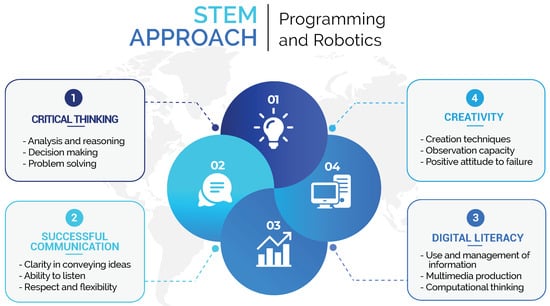
Figure 1.
In the context of the 21st century, developing strong educational skills is essential to address technological challenges; consequently, the STEM approach plays a key role in fostering skills such as programming and robotics.
Several research studies have shown that programming and robotics are the most challenging STEM subjects in the curriculum. One way to teach and learn programming is to encourage students through educational entertainment-based pedagogy that includes hands-on approaches to problem-solving [].
However, including and generating these concepts and knowledge from secondary education would substantially contribute to the development of cognitive thinking and problem-solving skills; with this, students could focus on providing several alternative solutions in different situations and areas of learning; therefore, programming is closely related to mathematics and physics; for example, this is evident in the resolution of graph theory problems [].
Educational Robotics (E.R.) is a pedagogical approach that promotes the development of technical skills, such as robot programming and design, and transversal skills, such as critical thinking, creativity, and teamwork []. For this reason, it is gaining relevance in formal and informal education as a key tool for developing contemporary competencies. Creating new educational trends requires research to analyze the limits and potential of these tools [].
The benefits of educational robotics, for example, would involve flexibility, open source development, and user-friendly interactions that allow students to explore and solve real-world problems, making them an effective way to engage young people to participate in STEM learning [].
Since technology and educational robotics constitute an essential component of STEM education, these tools facilitate the integration of fundamental principles such as engineering concepts and interdisciplinary approaches [].
In addition, educational robotics (E.R.) activities have shown a considerable increase in student engagement and participation in the learning process. The wide variety of RE activities engages students and, in some cases, may provide cognitive, social, and metacognitive benefits at all educational levels []. Therefore, RE activities could help teachers strive to make their classes more accessible and enjoyable.
Considering that the four skills that 21st-century students should possess refer to the Four C’s, namely creativity, critical thinking, communication, and collaboration, STEM education offers the opportunity to instill these skills and robotics as an effective tool that contributes to hands-on learning, not only in robotics-related subjects but also in STEM subjects [].
Robotics has many advantages in the teaching and learning process; therefore, the theory of constructivism is based on experiential learning in the classroom, emphasizing that children and youth can improve their cognitive and learning skills by combining and incorporating robotics in the learning process []. That is why an integrative curriculum is about removing these barriers between disciplines and increasing the usefulness of learning to address the disjointed and impractical knowledge problems that arise when investigating a specific topic [,].
Therefore, to improve teaching practice and enhance student learning, it is essential to implement innovative approaches in the classroom that foster personal transformation. It implies recognizing the role of preparing individuals capable of addressing contemporary challenges with the required competencies. However, traditional educational methods need to achieve this preparation adequately. As fundamental skills, robotics and programming promote the development of problem-solving, critical thinking, communication, flexibility, computational thinking, and innovation [,].
Educational tools that meet these needs should be available for educators to reach students in any STEM-centered environment. This approach is also adaptable to an extensive range of pedagogies, allowing for significant flexibility in curriculum design [,,].
Figure 2 presents a bibliometric analysis showing the high incidence and correlation in countries where programming and robotics, under the STEM approach, are central to education. The size of the circles indicates the highest incidence, while the colors represent the correlation between countries. The United States and China lead globally, while Brazil, Colombia, and Chile stand out. This phenomenon suggests that the integration of programming and robotics in education is driving new alternatives for teaching.
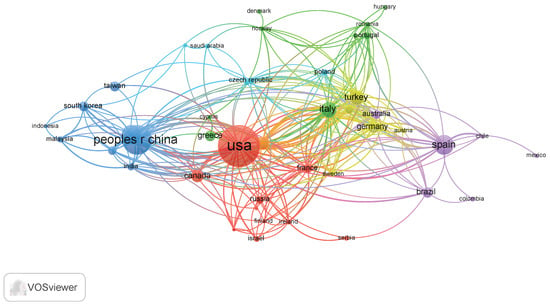
Figure 2.
Bibliometric.
The analysis focused on articles from 2020 to 2024, emphasizing keywords such as STEM, robotics, programming, and innovation. It highlights the effectiveness of STEM programs in scientific literacy and youth interest in science. These programs address real problems and promote applied education.
Figure 3 presents the scientific publications from global universities between 2019 and 2023 on STEM in education, focusing on programming and robotics. This research is evidence of the evolution of the topic and academic collaboration. They contribute to a multidisciplinary education that fosters students’ cognitive development, promoting their active role in learning.
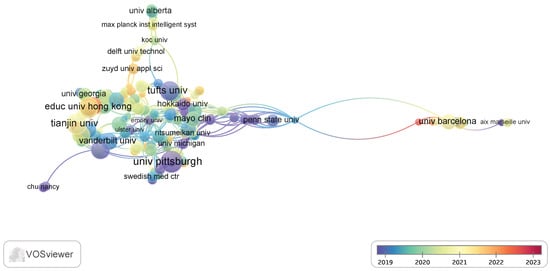
Figure 3.
Bibliometric analysis: Ratio of universities researching STEM, focusing on programming and robotics as educational alternatives, by years of publication. Database Scopus.
Several researchers argue in their scientific writings that STEM education implies a revolution in pedagogy by focusing on interdisciplinarity in teaching, together with the use of ICT, the promotion of creativity, and teamwork to develop soft skills necessary for a professional profile that solves the problems demanded by society; furthermore, these transformations are imperative in the education of the 21st century [].
The more they know about programming and how robots, smartphones, and other products are programmed, the sooner they can apply it to their daily lives; therefore, educational robotics must be implemented using simple and accessible tools.
To conclude this section, Table 1 shows the most relevant studies on the subject and justifies the relevance of this research to others already carried out.

Table 1.
Summary of studies on programming and robotics in STEM, considering the last four years, visualizations and academic scope.
3. Problem Formulation and Methodology
Today, education faces the challenge of not adequately adjusting to the demands of contemporary society in meeting the technological and scientific challenges of the 21st century. As a result, the effectiveness of the pedagogical methods and the content of the curricula have been subject to persistent criticism due to their insufficient quality, lack of flexibility, and lack of interdisciplinary approach.
The STEM educational approach, which integrates science, technology, engineering, and mathematics, has emerged as a central component in academic programs, as evidenced by the studies cited in Table 1. The study of programming and robotics is fundamental in this context. However, it is crucial to investigate and understand the precise impact of teaching these disciplines on developing critical skills, especially in secondary education.
Therefore, the problem is derived from the influence of learning programming and robotics with a STEM approach on the generation of interest in change and the motivation of secondary school students of the Ciudad de Girón Educational Unit. How are these interests and motivations linked to developing cognitive, creative, and problem-solving skills in this student group?
A strong STEM-focused curriculum is crucial to ensuring quality high school programming and robotics instruction. This curriculum must cultivate critical thinking, problem-solving, and creativity skills. Research identifies key content for comprehensive learning, promoting the integration of programming and robotics concepts and skills with other STEM areas by fostering interdisciplinarity.
The objective is to strengthen technical competencies and interdisciplinary strategies, promoting mathematical skills such as logical thinking, problem-solving, and data analysis. In addition, geometry, algebra, and data analysis skills are developed, and concepts are applied to practical contexts. Consequently, these activities are integrated into the standard classroom as valuable tools for interdisciplinary learning, allowing students to apply theoretical concepts in real projects.
This process is detailed in Figure 4 and Figure 5, which indicate the contents for higher primary education and high school, respectively.
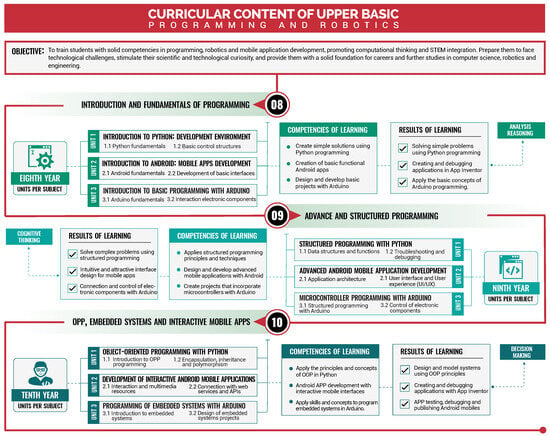
Figure 4.
Summary of the content, teaching strategies, and learning objectives for secondary education. Source: Authors.
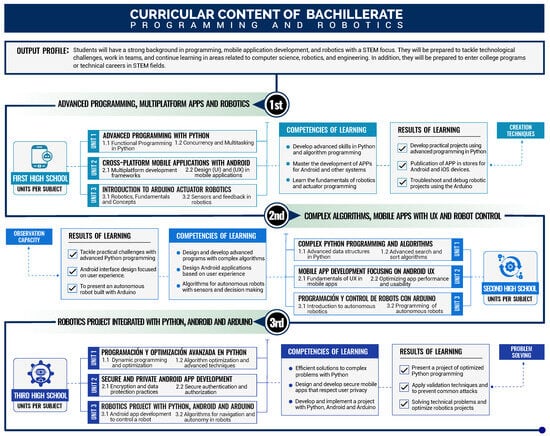
Figure 5.
Overview of the content, strategies, and learning objectives for the baccalaureate, based on the student’s exit profile. Source: Authors.
This process involves identifying the tools available to students to facilitate their interaction with programming. These tools include computers, mobile devices, and external components in the context of robotics. The main objective is to enable students to apply the acquired knowledge practically and evaluate the curriculum’s relevance in real-world situations, optimizing the effective resolution of challenges and problems.
The secondary education curriculum has been conceived to foster cognitive skills, reasoning analysis, and decision-making. These contents have been designed coherently throughout the different levels and learning themes. In the eighth year, priority is given to acquiring fundamental concepts in programming and robotics, along with developing skills in Python, Android, and Arduino, thus emphasizing the formation of a solid foundation and strengthening analytical and decision-making skills in secondary education.
In the ninth year, the curriculum focuses on developing skills in structured programming with Python, creating advanced Android applications, and microcontroller programming with Arduino. It prepares students to tackle problems effectively, design high-quality interfaces, and devise innovative solutions integrating sensors, actuators, and control. This process fosters logical thinking and the creation of scalable solutions in computing and technology.
In the tenth year, training focuses on object-oriented programming, interactive mobile application development, and embedded systems programming. This phase culminates with students’ movement in good programming practices and user-friendly interface design. It is complemented by Arduino programming for embedded systems, which provides solutions to real problems. The baccalaureate-level curriculum is meticulously structured to promote the development of cognitive skills inherent to the STEM disciplines, namely creativity, problem-solving, observational, and communication acumen.
This enrichment in competencies will undoubtedly catalyze the emergence of innovative approaches to addressing the challenges that characterize the 21st century. In the first year of high school, the content focuses on providing students with advanced Python programming skills to design complex programs and master algorithms and data structures. In addition, skills are developed in creating multiplatform mobile applications and fostering versatile Android, iOS, and other systems solutions. Likewise, fundamental robotics concepts are incorporated, cultivating practical skills in building and programming robotic projects with Arduino.
The second year of high school’s curriculum focuses on advanced programming and complex algorithms in Python, emphasizing search and sort algorithms. It also addresses Android mobile application development, focusing on user experience and programming and controlling autonomous robots using Arduino. This educational approach significantly improves students’ ability to analyze and solve real-world problems and propose strategies for making smarter decisions in their environment.
During the last year of the high school cycle, the pedagogical focus was on realizing a robotics project that amalgamates Python, Android, and Arduino. In such a project, students will exhibit proficiency in programming, electronics, and hardware control. They will actively execute an integral enterprise that encapsulates the synergy between these three platforms, sustained by a multidisciplinary approach and its concrete application in real-world contexts.
Upon completing the proposed curricular program, students are encouraged to develop a solid profile in programming, mobile application design and development, and robotics within the STEM context.
This training will provide them with the necessary skills to address technological challenges successfully, collaborate effectively in teamwork environments, and continue their education in areas related to computer science, robotics, and engineering. In addition, they will be adequately prepared to enter university programs or technical careers in STEM fields.
This study employs a methodology that begins with a historical-descriptive approach. It conducts a comprehensive global, regional, and national literature review on integrating programming and robotics in education, as detailed in Table 1 of the state of the art. In addition, a bibliometric analysis is carried out using VosViewer software, 1.6.20 version to identify countries and universities that excel in research related to the STEM approach in education.
The literature review used the Web of Science and Scopus databases as reference sources. Based on this exhaustive review, a state-of-the-art matrix covered the positive aspects and the problems addressed in the relevant studies. The search and filter criteria focused on the restriction of the publication period between 2021 and 2023 and the use of keywords related to the research topic, as the flow of this process can be seen in the attached Figure 6.
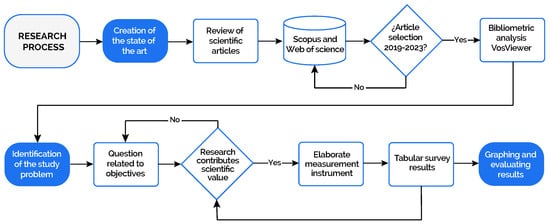
Figure 6.
Flowchart of the methodological process adopted to clarify the sequence of the stages carried out in this study. Source: Authors.
In a subsequent stage, the experimental method was implemented to discern the impact on the interest and motivation of higher primary education students concerning learning programming and robotics in the context of a STEM approach. Then, to achieve this purpose, a coherent and sequential curriculum content was established and defined, adapted to the context and its applicability.
Data collection was carried out using Likert scales, following a quantitative methodology; the results obtained will be evaluated through an analytical–synthetic approach, which will facilitate the comparison and contrast of the objectives outlined about the findings achieved during the research.
This methodological approach will allow for a thorough exploration and synthesis of the data, evaluating the coherence between the study’s objectives and the empirical results obtained.
In this phase of the study, two surveys were elaborated, one with 31 questions addressed to students and the other with 25 questions addressed to teachers. The study population consisted of 70 students belonging to the eighth years of parallel years A and B of General Basic Education, ranging in age from 11 to 14.
Twenty-two teachers who teach General Basic Education and High School at the Ciudad de Girón Educational Unit, a public institution with an educational proposal for Technical High School in Computer Science, were included. This institution is located in the Girón canton, in an urban area, and is part of the Education District 01D03 Girón a Santa Isabel.
The method was implemented using the Microsoft Forms online platform to create and distribute the questionnaire. This questionnaire was comprehensively structured and included various aspects, such as digital literacy, familiarity with and previous experience with the STEM educational approach, learning content linked to Programming and Robotics, and adopting innovative practices in comprehensive and inclusive education.
The quantitative and qualitative data will allow us to analyze student and teacher perceptions of STEM. Patterns will be identified through percentages and arithmetic means. Segmentation by variables such as age or experience will enrich the analysis, and the diversity of the population studied will reinforce statistical validity.
Considering previous research, this methodological approach is aligned with the study’s objectives. The survey used a five-item Likert scale to assess students’ and teachers’ perceptions.
These items were defined as follows: “Strongly agree (Q1)”, “Agree (Q2)”, “Undecided (Q3)”, “Disagree (Q4)”, and “Strongly disagree (Q5)”. Table 2 shows the questions asked in the student survey, organized into five groups. Similarly, Table 3 presents the questions asked in the teacher survey.

Table 2.
Survey based on five-point Likert scale—Students.

Table 3.
Survey based on five-point Likert scale—Teachers.
4. Analysis of Results
The present document carefully analyzed the collected data after completing surveys for eighth-grade students and teachers in the mentioned educational institution. This analysis aims to reveal the perceptions, patterns, and effects of implementing Programming and Robotics within the curriculum’s framework of the STEM approach. It focuses on assessing the impact on students and exploring dimensions such as acceptance and motivation. In addition, the essential role of the STEM approach in the integral formation of learners is rigorously examined.
In this context, Figure 7 presents the results of student responses concerning each question asked and evaluated using the Likert scale, highlighting the prevalence of the “Agree” option. In particular, in the question about interest in participating in projects to build and program LEGO robots, the response “Strongly Agree” was predominant, with 32 students. “Undecided” answers are minimal, with 16 responses in aspect 4 being the most prominent, while the “Disagree” and “Strongly Disagree” options show deficient levels, with only four students opting for these alternatives in all five aspects.
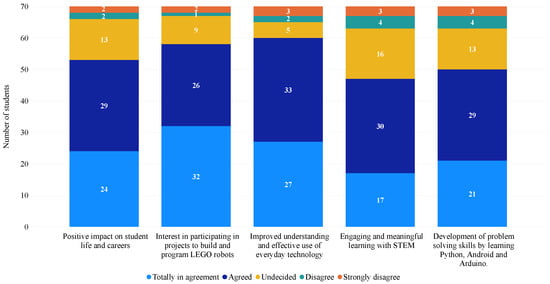
Figure 7.
Students Survey: Highlights of the STEM approach to learning by integrating Programming and Robotics. Source: Authors.
These results underscore students’ marked acceptance and enthusiasm toward integrating the STEM approach to learning through Programming and Robotics. Furthermore, they highlight the relevance of considering prior knowledge, skills, and developmental goals for effectively implementing these educational initiatives.
In Figure 8a, which exhibits the curricular content related to programming in Python, an analysis of the questions related to learning programming and robotics in the STEM context was conducted. Interest was highlighted, and information on the level of prior knowledge and experience was provided. About question 15, which addresses Programming Fundamentals and Control Structures in Python, it is observed that 32.9% of students chose the option “Strongly Agree” and 50.0% “Agree”. In addition, 8.6% of students checked the “Undecided” option, 5.7% “Disagree”, and only 2.8% responded, “Strongly Disagree”. This result points to a connection with the STEM approach by highlighting the practical application of programming in real-world situations.
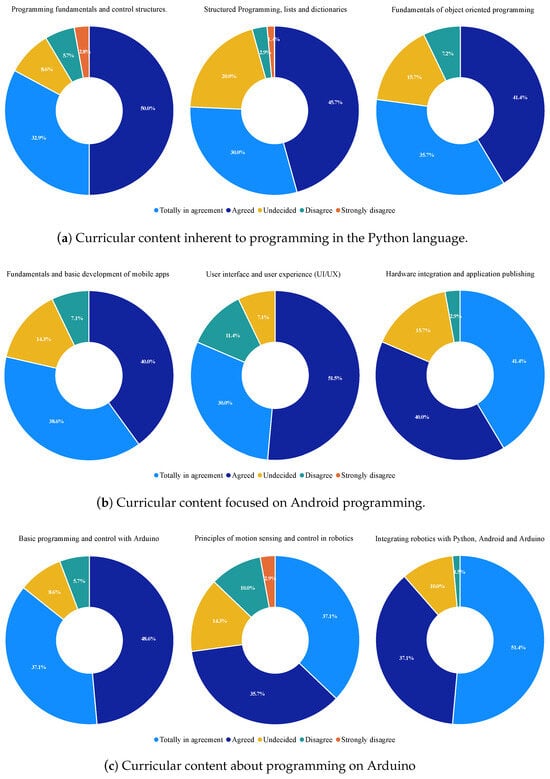
Figure 8.
Students survey: Programming and robotics content adapted to support the development of relevant skills and knowledge in the context of the STEM approach—(a) Content related to Python. (b) Contents addressing Android. (c) Contents about Arduino. Source: Authors.
In the same context, about questions 21 and 23, which address content on structured programming and object-oriented programming in Python, it is noted that 30% and 35.7% of students, respectively, “Completely agree” with these contents. Likewise, 45.7% of students expressed “Agree” with the topic addressed in question 21, while 41.4% responded “Agree” about the content of question 23.
On the other hand, it is essential to note a low number of negative responses to both questions mentioned above. In question 21, only 2.9% of students expressed “Disagree”, while in question 23, 7.1% opted for that option. Consequently, the contents presented contribute to the development of fundamental programming skills. In addition, the focus on object-oriented programming and its relevance in the educational field is highlighted, highlighting how it can be efficiently applied to manage data.
Figure 8b refers to the curricular contents focused on Android programming, highlighting the practical application of programming in the development of mobile applications, underlining the connection between programming and design skills, and encouraging creativity and sharing results, essential aspects for the STEM approach, highlighting as the highest point the topic of Hardware integration and application publishing where 41.4% of students responded “Strongly Agree” based on these contents. At the same time, the lowest level of response, “Disagree” is 2.9% of respondents.
In the curricular contents linked to the fundamentals and essential development of mobile applications, as well as the user interface and user experience, which are mentioned in questions 18 and 20, it is observed that 38.6% and 30.0% of the students responded with “Strongly agree” and 40.0% and 51.5% marked the option “Agree”, respectively, to the questions mentioned above. However, some responses presented a low level to the option “Disagree”, registering 7.1% and 11.4% of the respondents. Notably, no answers were recorded for “Strongly disagree” with the above-mentioned questions and contents.
Figure 8c establishes the sequence of curricular contents relevant to programming on Arduino, based on questions 19 and 22, which address Basic programming and control with Arduino and principles of motion sensing and control in robotics. Positive responses from students were observed, highlighting the options “Strongly Agree” and “Agree” with a total of 37.1% and 48.6% of answers for question 19. As for question 22, 37.1% of responses were recorded for the option “Strongly agree” and 35.7% of responses for the option “Agree”. It is relevant to point out that the alternatives “Undecided”, “Disagree”, and “Strongly disagree” obtained a low response rate without exceeding 10% of the total number of respondents.
In addition, it is imperative to highlight that, for question 25, which mentions the integration of robotics through Python, Android, and Arduino in an interdisciplinary project, 51.4% of the students expressed their position with “Strongly agree”, while 37.1% opted for the option “Agree”. These responses highlight students’ interest in applying programming and robotics concepts in practical projects. These projects effectively integrate STEM skills and provide a hands-on experience that can be engaging and stimulating for students.
Figure 9 reveals the teachers’ perspective regarding integrating STEM in programming and robotics instruction in secondary education, highlighting it as a positive strategy to enhance educational quality. Question 12, focused on facilitating the practical application of commonly used technologies, shows high support, evidenced by 11 teachers expressing “Strongly Agree” and seven teachers marking the “Agree” option. However, the other options reflect more limited participation by teachers.

Figure 9.
Teachers Survey: Contribution of the STEM approach as disciplinary integration in learning programming and robotics. Source: Authors.
In questions 9 and 10, which focused on fostering interdisciplinarity and strengthening academic performance, a marked acceptance is evident, with 9 and 8 “Strongly Agree” responses, respectively, and 8 and 10 responses in the “Agree” category. On the other hand, the “Undecided” options registered three and two responses, respectively, while reactions in the “Disagree” category were limited. In the same context, regarding the positive impact on teaching–learning and teaching career, eight respondents opted for “Strongly Agree”, 13 teachers selected “Agree”, and only one teacher expressed undecided.
Notably, eight teachers expressed “Strongly Agree” regarding improving academic performance in various areas of knowledge through learning programming and robotics, while nine indicated “Agree”. On the other hand, two teachers responded in the categories of “Undecided” and “Disagree”.
Ultimately, a synthesis highlights the relevance of the teaching perspective on how the insertion of STEM programming and robotics positively impacts pedagogy, raises educational quality standards, fosters interdisciplinarity, boosts academic performance, and facilitates the adoption of standard technologies in the classroom. Consequently, these responses are crucial to guide educational strategies for effectively implementing the STEM approach in the secondary education curriculum.
Figure 10a analyzes the teaching approach to Integral and Inclusive Educational Innovation through learning programming and robotics with STEM. It examines various aspects, including developing problem-solving skills related to inclusion and diversity, addressing problems in innovative and fun ways, and fostering inclusion regardless of gender.

Figure 10.
Teachers and students survey: Inclusion of diverse students in STEM, focusing on programming and robotics with diverse skills and needs—(a) Teachers’ perspective. (b) Students’ perspective. Source: Authors.
In this context, in question 21, related to developing skills to address inclusive challenges, the teachers recorded nine responses in the “Strongly agree” and “Agree” categories. Of 22 respondents, only two expressed indecision, and one teacher disagreed. Consequently, this directly addresses the consideration of social impact and the skills that students are likely to acquire.
On the other hand, when addressing the strategy of facing problems innovatively and playfully, the teachers’ answers reflect that six expressed a position of “Totally agree”, while 14 opted for the alternative “Agree”. Only two teachers said indecision in this regard. In the last consideration, it stands out that learning programming and robotics is perceived as inclusive regardless of gender, with 11 teachers marking “Strongly agree” and nine selecting “Agree”. This analysis reveals a low response rate in the “Undecided” and “Disagree” categories. Consequently, valuable insights are provided on the social, creative, and inclusionary impact of learning programming and robotics on high school students.
Figure 10b shows the student perspective on educational innovation, focusing on a comprehensive approach to learning programming and robotics. Elements concerning equal opportunities, gender equity, inclusion, understanding, and ingenious problem-solving stand out. From the analysis of question 28, linked to the equity of opportunities in STEM learning, it is observed that 20 respondents chose the alternative “Totally agree”, while 39 students expressed their agreement. In addition, eight students were undecided, while only three picked the option “Disagree”.
Regarding the students’ position regarding the alternative concerning inclusion and gender equity, 29 respondents selected the option “Totally agree”. In addition, 24 students expressed their agreement. Likewise, 14 students chose the option “Undecided”, while two indicated that they disagreed.
Finally, the contribution derived from learning programming and robotics has the potential to enhance understanding and ingenious problem-solving. As a result, 26 students strongly agreed, while 30 agreed with this proposition. In addition, a low rate is observed for the “Undecided” options, with ten responses and only four for the “Disagree” option. Therefore, this information is essential to understanding how teaching programming and robotics, particularly under a STEM approach, influences students’ experience and development.
Consequently, the correlation between teachers’ and students’ perspectives denotes a significant understanding of the positive social and educational impact that programming and robotics, particularly under a STEM approach, can have on elementary school students. This phenomenon implies a recognition of the relevance of cultivating practical skills, stimulating creativity and innovation, and advocating for gender equality in the learning process.
Based on the analysis of the results presented in Figure 11a, which addresses the impact of learning programming and robotics on 21st-century skills, teachers identify essential elements for preparing students for the challenges of the contemporary world. These skills encompass vital aspects such as critical thinking, problem-solving, creativity, effective communication, and digital literacy. In this context, in the development of critical thought, 54.5% of the participants selected the option “Strongly agree”, while 40.9% agreed. Only 4.5% said indecision in this regard.
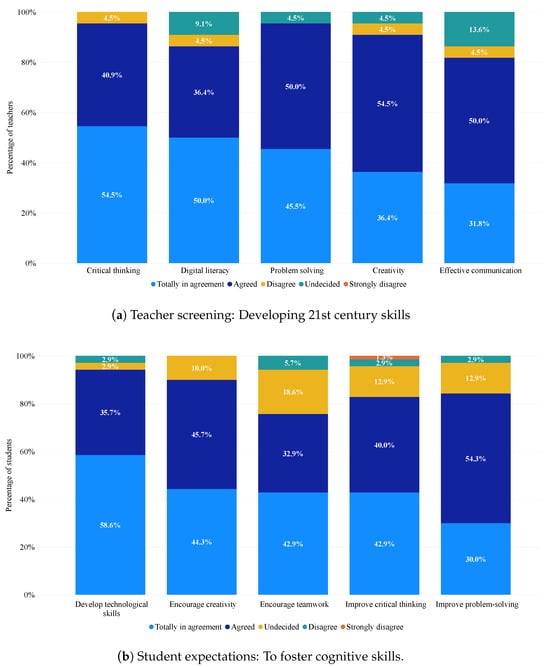
Figure 11.
Teachers and students survey: The interrelationship between cognitive skills and those corresponding to the 21st century through instruction in programming and robotics within the STEM approach—(a) Teachers’ perspective. (b) Students’ perspective. Source: Authors.
Regarding the skill related to digital literacy, 50.0% indicated “Strongly agree”, and 36.4% agreed with the statement that students should be familiarized with advanced tools and technologies. The “Undecided” and “Disagree” options present low percentages in the responses, with 9.1% being the most significant proportion. Additionally, the competencies associated with problem-solving and creativity reached outstanding percentages in the “Strongly Agree” and “Agree” categories. The low level of participation in the “Disagree” option stands out, which registered only 4.5%, both for problem-solving and creativity.
Finally, concerning adequate communication competence, 31.8% of the teachers were in the “Strongly Agree” category, while 50.0% selected the “Agree” option. Likewise, 4.5% were undecided, and 13.6% disagreed as to the effectiveness of fostering this skill through learning programming and robotics. Consequently, based on the elements previously analyzed, it is feasible to identify how learning Programming and Robotics contributes to developing 21st-century skills, transcending the mere transmission of technical knowledge. This discipline is integral to cultivating essential skills and preparing students for an increasingly digital and collaborative future.
Figure 11b presents the student perspective regarding developing and fostering cognitive skills through learning programming and robotics within the STEM framework. It further highlights how these skills can contribute positively to the impact of the learning process at hand.
Students evaluated the importance of fostering creativity and teamwork in the learning process, registering 44.3% and 42.9 %, respectively, in the “Strongly agree” option. Likewise, 45.7% and 32.9% agreed with the cultivation of these cognitive skills. An “Undecided” response choice was observed for both skills, with 10.0% and 18.6 %, respectively. Only 5.7% of respondents expressed disagreement with the importance of teamwork.
Likewise, positive results were observed in the option related to the development of technological skills, where 58.6% of the students indicated that they “Totally agree”. In addition, 35.7% selected the option “Agree”. Therefore, these results suggest the importance of linking learning with technology. A low percentage of responses in the possibilities “Undecided” and “Disagree” is worth noting, registering 2.9% of the total surveyed.
Finally, 30% of the participants selected the option “Strongly agree,” while 54.3% expressed “Agree” with the statement that learning programming and robotics would improve problem-solving in various subjects. In addition, only 12.9% said indecision regarding the development of this skill, and 2.9% indicated disagreement. Consequently, it is inferred that the learning process of programming and robotics plays a fundamental role in developing cognitive skills. These skills are not only of paramount importance in the context of STEM but also have a beneficial impact on the overall development of the student and their projection as a future professional.
Therefore, the convergence of teacher and student perspectives highlights the positive and fundamental importance of programming and robotics in STEM for cognitive development and preparation for critical 21st-century skills. This comprehensive education transcends traditional conventions, providing students with a foundation that expands their mental skills and enables them to meet the demands of an increasingly technological and collaborative global environment.
5. Conclusions
Previous research has addressed the integration of programming and robotics into the school curriculum, showing substantial improvements in academic performance and active student participation. The relevance of this topic is based on the growing demand for STEM skills in contemporary society, underlining the pressing need for a thorough understanding of the educational impact inherent to these disciplines.
In line with this context, the present research validates two assumptions regarding students’ and teachers’ motivation for change by proposing curricular content in Programming and Robotics under a STEM Educational Approach. This approach seeks to consolidate and expand the existing knowledge on the educational benefits of programming and robotics, thus contributing to the evolution and adaptation of pedagogical methods in the STEM environment. The intrinsic aptitude of this methodology to enhance cognitive and 21st-century skills in students, stimulating critical thinking, problem-solving skills, and creativity, has also been highlighted.
Prior knowledge of the STEM educational approach and programming and robotics content in high school teachers and students reveals a transcendence beyond traditional disciplinary boundaries. This approach provides a pedagogical platform that prepares students to face the challenges of an increasingly technological and collaborative world.
The majority of participants, teachers, and students support the inclusion of teaching programming and robotics with a STEM approach starting in the eighth grade of EGB, evidencing a recognition of the importance of introducing these subjects at early educational stages. In addition, there is a high degree of agreement that a STEM approach would make learning more attractive and meaningful, revealing a palpable interest in educational methods oriented toward practice and application.
One aspect of relevance highlights the need to expand programming and robotics content at all educational levels to strengthen the skills and knowledge associated with STEM. The acceptance of the inclusion of specific topics such as Python, Android, and Arduino reflects an evident interest in acquiring skills with practical applications that are in demand in the contemporary environment.
The curricular content for programming and robotics is meticulously designed to ensure a logical and coherent sequence. It comprehensively addresses fundamental aspects of both disciplines, providing educational progression. Integrating the STEM approach enriches the learning experience by establishing connections between programming and robotics and science, technology, engineering, and mathematics, thereby fostering an interdisciplinary perspective in students.
Furthermore, implementing programming and robotics learning within the STEM framework can act as an inclusive and equitable mechanism for overcoming gender barriers. By recognizing and valuing diverse skills and individual strengths, this approach encourages equal opportunities for all. It also emphasizes innovative and playful problem-solving through technology, enriching students’ resolution strategies.
This type of learning is not merely seen as preparation for higher STEM studies but also as a contributor to deeper understanding and ingenious problem-solving across various disciplines. Our research unequivocally demonstrates the positive impact and motivation for change derived from learning programming and robotics in elementary school students. This educational approach, especially within the STEM framework, inculcates fundamental technical skills and strengthens essential cognitive skills like critical thinking, problem-solving, and creativity.
The findings reveal an intricate connection between theory and practical application, enhancing the relevance and appeal of the learning process. This perspective is a holistic tool that effectively prepares students for the challenges of an increasingly technological and collaborative society, underscoring its integral relevance in the Basic Education setting.
Based on the considerations presented in this document, the government needs to develop and implement educational policies. These policies should substantially improve public education using a contextualized and adaptable curriculum. Providing the physical and technological infrastructure that ensures educational equity and fosters a collaborative learning approach is crucial. This approach must be congruent with technological advances and respond to the academic demands inherent to the 21st century.
Author Contributions
I.T. conceptualized the study, analyzed the data, and wrote the initial draft. E.I. analyzed the data and revised the draft. I.T. provided critical feedback and edited the manuscript. E.I. provided Zoom support and critical feedback. All authors have read and agreed to the published version of the manuscript.
Funding
Universidad Politécnica Salesiana and GIREI supported this work, Smart Grid Research Group, under the project Information and Communication Technologies for Education considering learning engineering.
Institutional Review Board Statement
Not applicable.
Informed Consent Statement
Informed consent is obtained from all subjects involved in the study.
Data Availability Statement
Data are contained within the article.
Acknowledgments
Universidad Politécnica Salesiana and GIREI supported this work—Smart Grid Research Group and the Master’s Program in Information and Communication Technologies for Education. The Network IUS also provided the funding-RECI-Smart Grid and Smart Cities.
Conflicts of Interest
The authors declare no conflicts of interest.
References
- Kálózi-Szabó, C.; Mohai, K.; Cottini, M. Employing Robotics in Education to Enhance Cognitive Development—A Pilot Study. Sustainability 2022, 14, 5951. [Google Scholar] [CrossRef]
- Kucuk, S.; Sisman, B. Students’ attitudes towards robotics and STEM: Differences based on gender and robotics experience. Int. J.-Child-Comput. Interact. 2020, 23–24, 100167. [Google Scholar] [CrossRef]
- Inga, E.; Inga, J.; Cárdenas, J. Planning and Strategic Management of Higher Education Considering the Vision of Latin America. Educ. Sci. 2021, 11, 188. [Google Scholar] [CrossRef]
- Surahman, E.; Wang, T.H. In-service STEM teachers professional development programmes: A systematic literature review 2018–2022. Teach. Teach. Educ. 2023, 135, 104326. [Google Scholar] [CrossRef]
- Cueva, A.; Inga, E. Information and Communication Technologies for Education Considering the Flipped Learning Model. Educ. Sci. 2022, 12, 207. [Google Scholar] [CrossRef]
- Ferrada, C.; Carrillo-Rosúa, F.J.; Díaz-Levicoy, D.; Silva-Díaz, F. La robótica desde las áreas STEM en Educación Primaria: Una revisión sistemática. Educ. Knowl. Soc. (EKS) 2020, 21, 18. [Google Scholar] [CrossRef]
- Inga, E.; Inga, J. Innovación Educativa para Gestión y Planeación de la Educación Superior Basado en Responsabilidad Social. In Estrategias Didácticas Para la Innovación en la Sociedad del Conocimiento; CIMTED: Antioquia, Colombia, 2019; pp. 13–35. [Google Scholar]
- Angel-Fernandez, J.M.; Vincze, M. Towards a Formal Definition of Educational Robotics. Smart Learn. Educ. Robot. 2018, 1, 37–42. [Google Scholar] [CrossRef]
- Bertrand, M.G.; Namukasa, I.K. STEAM education: Student learning and transferable skills. J. Res. Innov. Teach. Learn. 2020, 13, 43–56. [Google Scholar] [CrossRef]
- Rivadeneira, J.; Inga, E. Interactive Peer Instruction Method Applied to Classroom Environments Considering a Learning Engineering Approach to Innovate the Teaching–Learning Process. Educ. Sci. 2023, 13, 301. [Google Scholar] [CrossRef]
- Arabit-García, J.; García-Tudela, P.A.; Prendes-Espinosa, M.P. Uso de tecnologías avanzadas para la educación científica. Rev. Iberoam. Educ. 2021, 87, 173–194. [Google Scholar] [CrossRef]
- Barnes, J.; Fakhrhosseini, S.M.; Vasey, E.; Park, C.H.; Jeon, M. Child-Robot Theater: Engaging Elementary Students in Informal STEAM Education Using Robots. IEEE Pervasive Comput. 2020, 19, 22–31. [Google Scholar] [CrossRef]
- Yangari, M.; Inga, E. Article educational innovation in the evaluation processes within the flipped and blended learning models. Educ. Sci. 2021, 11, 487. [Google Scholar] [CrossRef]
- Albarello, F.; Hafner Táboas, A. Programación y robótica: Cómo y para qué. Análisis de las políticas educativas en Argentina. Contratexto 2019, 2018, 71–93. [Google Scholar] [CrossRef]
- Kutnick, P.; Lee, B.P.Y.; Chan, R.Y.Y.; Chan, C.K.Y. Students’ engineering experience and aspirations within STEM education in Hong Kong secondary schools. Int. J. Educ. Res. 2020, 103, 101610. [Google Scholar] [CrossRef]
- Eltanahy, M.; Forawi, S.; Mansour, N. Incorporating Entrepreneurial Practices into STEM Education: Development of Interdisciplinary E-STEM Model in High School in the United Arab Emirates. Think. Ski. Creat. 2020, 37, 100697. [Google Scholar] [CrossRef]
- Coufal, P. Project-Based STEM Learning Using Educational Robotics as the Development of Student Problem-Solving Competence. Mathematics 2022, 10, 4618. [Google Scholar] [CrossRef]
- Ou Yang, F.C.; Lai, H.M.; Wang, Y.W. Effect of augmented reality-based virtual educational robotics on programming students’ enjoyment of learning, computational thinking skills, and academic achievement. Comput. Educ. 2023, 195, 104721. [Google Scholar] [CrossRef]
- Bachiller-Burgos, P.; Barbecho, I.; Calderita, L.V.; Bustos, P.; Manso, L.J. LearnBlock: A Robot-Agnostic Educational Programming Tool. IEEE Access 2020, 8, 30012–30026. [Google Scholar] [CrossRef]
- Mangina, E.; Psyrra, G.; Screpanti, L.; Scaradozzi, D. Robotics in the Context of Primary and Preschool Education: A Scoping Review. IEEE Trans. Learn. Technol. 2024, 17, 342–363. [Google Scholar] [CrossRef]
- Shibata, M.; Demura, K.; Hirai, S.; Matsumoto, A. Comparative Study of Robotics Curricula. IEEE Trans. Educ. 2021, 64, 283–291. [Google Scholar] [CrossRef]
- Cárdenas, J.; Inga, E. Methodological experience in the teaching-learning of the English language for students with visual impairment. Educ. Sci. 2021, 11, 515. [Google Scholar] [CrossRef]
- Govender, R.G.; Govender, D.W. A Physical Computing Approach to the Introduction of Computer Programming among a Group of Pre-service Teachers. Afr. J. Res. Math. Sci. Technol. Educ. 2021, 25, 54–65. [Google Scholar] [CrossRef]
- Ramirez, A. Educational Innovation in Adult Learning Considering Digital Transformation for Social Inclusion. Educ. Sci. 2022, 12, 882. [Google Scholar] [CrossRef]
- Fridberg, M.; Redfors, A. Teachers’ and children’s use of words during early childhood STEM teaching supported by robotics. Int. J. Early Years Educ. 2021, 32, 2599. [Google Scholar] [CrossRef]
- Sáez López, J.M.; Otero, R.B.; De Lara García-Cervigón, S. Introducing robotics and block programming in elementary education. RIED-Rev. Iberoam. Educ. Distancia 2021, 24, 95–113. [Google Scholar] [CrossRef]
- Rapti, S.; Sapounidis, T. Computers & Education “Critical thinking, Communication, Collaboration, Creativity in kindergarten with Educational Robotics”: A scoping review (2012–2023). Comput. Educ. 2024, 210, 104968. [Google Scholar] [CrossRef]
- Korhonen, T.; Salo, L.; Laakso, N.; Seitamaa, A.; Sormunen, K.; Kukkonen, M.; Forsström, H. Finnish teachers as adopters of educational innovation: Perceptions of programming as a new part of the curriculum. Comput. Sci. Educ. 2022, 33, 94–116. [Google Scholar] [CrossRef]
- Montuori, C.; Gambarota, F.; Altoé, G.; Arfé, B. The cognitive effects of computational thinking: A systematic review and meta-analytic study. Comput. Educ. 2024, 210, 104961. [Google Scholar] [CrossRef]
- Zhao, D.; Muntean, C.H.; Chis, A.E.; Rozinaj, G.; Muntean, G.M. Game-Based Learning: Enhancing Student Experience, Knowledge Gain, and Usability in Higher Education Programming Courses. IEEE Trans. Educ. 2022, 65, 502–513. [Google Scholar] [CrossRef]
- Bråting, K.; Kilhamn, C. The Integration of Programming in Swedish School Mathematics: Investigating Elementary Mathematics Textbooks. Scand. J. Educ. Res. 2022, 66, 594–609. [Google Scholar] [CrossRef]
- Malinverni, L.; Valero, C.; Schaper, M.M.; de la Cruz, I.G. Educational Robotics as a boundary object: Towards a research agenda. Int. J.-Child-Comput. Interact. 2021, 29, 100305. [Google Scholar] [CrossRef]
- Shang, X.; Jiang, Z.; Chiang, F.K.; Zhang, Y.; Zhu, D. Effects of robotics STEM camps on rural elementary students’ self-efficacy and computational thinking. Educ. Technol. Res. Dev. 2023, 1, 26. [Google Scholar] [CrossRef]
- Darmawansah, D.; Hwang, G.J.; Chen, M.R.A.; Liang, J.C. Trends and research foci of robotics-based STEM education: A systematic review from diverse angles based on the technology-based learning model. Int. J. STEM Educ. 2023, 10, 12. [Google Scholar] [CrossRef]
- Tselegkaridis, S.; Sapounidis, T. Exploring the Features of Educational Robotics and STEM Research in Primary Education: A Systematic Literature Review. Educ. Sci. 2022, 12, 305. [Google Scholar] [CrossRef]
- Üçgül, M.; Altıok, S. You are an astroneer: The effects of robotics camps on secondary school students’ perceptions and attitudes towards STEM. Int. J. Technol. Des. Educ. 2022, 32, 1679–1699. [Google Scholar] [CrossRef]
- Chootongchai, S.; Songkram, N.; Piromsopa, K. Dimensions of robotic education quality: Teachers’ perspectives as teaching assistants in Thai elementary schools. Educ. Inf. Technol. 2021, 26, 1387–1407. [Google Scholar] [CrossRef]
- Chang, C.C.; Chen, Y. Cognition, Attitude, and Interest in Cross-Disciplinary i-STEM Robotics Curriculum Developed by Thematic Integration Approaches of Webbed and Threaded Models: A Concurrent Embedded Mixed Methods Study. J. Sci. Educ. Technol. 2020, 29, 622–634. [Google Scholar] [CrossRef]
- Encarnação, P.; Leite, T.; Nunes, C.; Nunes da Ponte, M.; Adams, K.; Cook, A.; Caiado, A.; Pereira, J.; Piedade, G.; Ribeiro, M. Using assistive robots to promote inclusive education. Disabil. Rehabil. Assist. Technol. 2017, 12, 352–372. [Google Scholar] [CrossRef] [PubMed]
- Turan, S.; Aydoğdu, F. Effect of coding and robotic education on pre-school children’s skills of scientific process. Educ. Inf. Technol. 2020, 25, 4353–4363. [Google Scholar] [CrossRef]
- Mishra, D.; Parish, K.; Lugo, R.G.; Wang, H. A framework for using humanoid robots in the school learning environment. Electronics 2021, 10, 756. [Google Scholar] [CrossRef]
- Stein, G.; Jean, D.; Brady, C.; Lédeczi, Á. Browser-based simulation for novice-friendly classroom robotics. Front. Comput. Sci. 2023, 4, 1–13. [Google Scholar] [CrossRef]
- Stupurienė, G.; Lucas, M.; Bem-Haja, P. Teachers’ perceptions of the barriers and drivers for the integration of Informatics in primary education. Comput. Educ. 2024, 208, 104939. [Google Scholar] [CrossRef]
- López-Belmonte, J.; Segura-Robles, A.; Moreno-Guerrero, A.J.; Parra-González, M.E. Robotics in education: A scientific mapping of the literature in web of science. Electronics 2021, 10, 291. [Google Scholar] [CrossRef]
- Fridberg, M.; Redfors, A.; Greca, I.M.; Terceño, E.M. Spanish and Swedish teachers’ perspective of teaching STEM and robotics in preschool—results from the botSTEM project. Int. J. Technol. Des. Educ. 2022, 33, 1–21. [Google Scholar] [CrossRef]
Disclaimer/Publisher’s Note: The statements, opinions and data contained in all publications are solely those of the individual author(s) and contributor(s) and not of MDPI and/or the editor(s). MDPI and/or the editor(s) disclaim responsibility for any injury to people or property resulting from any ideas, methods, instructions or products referred to in the content. |
© 2025 by the authors. Licensee MDPI, Basel, Switzerland. This article is an open access article distributed under the terms and conditions of the Creative Commons Attribution (CC BY) license (https://creativecommons.org/licenses/by/4.0/).